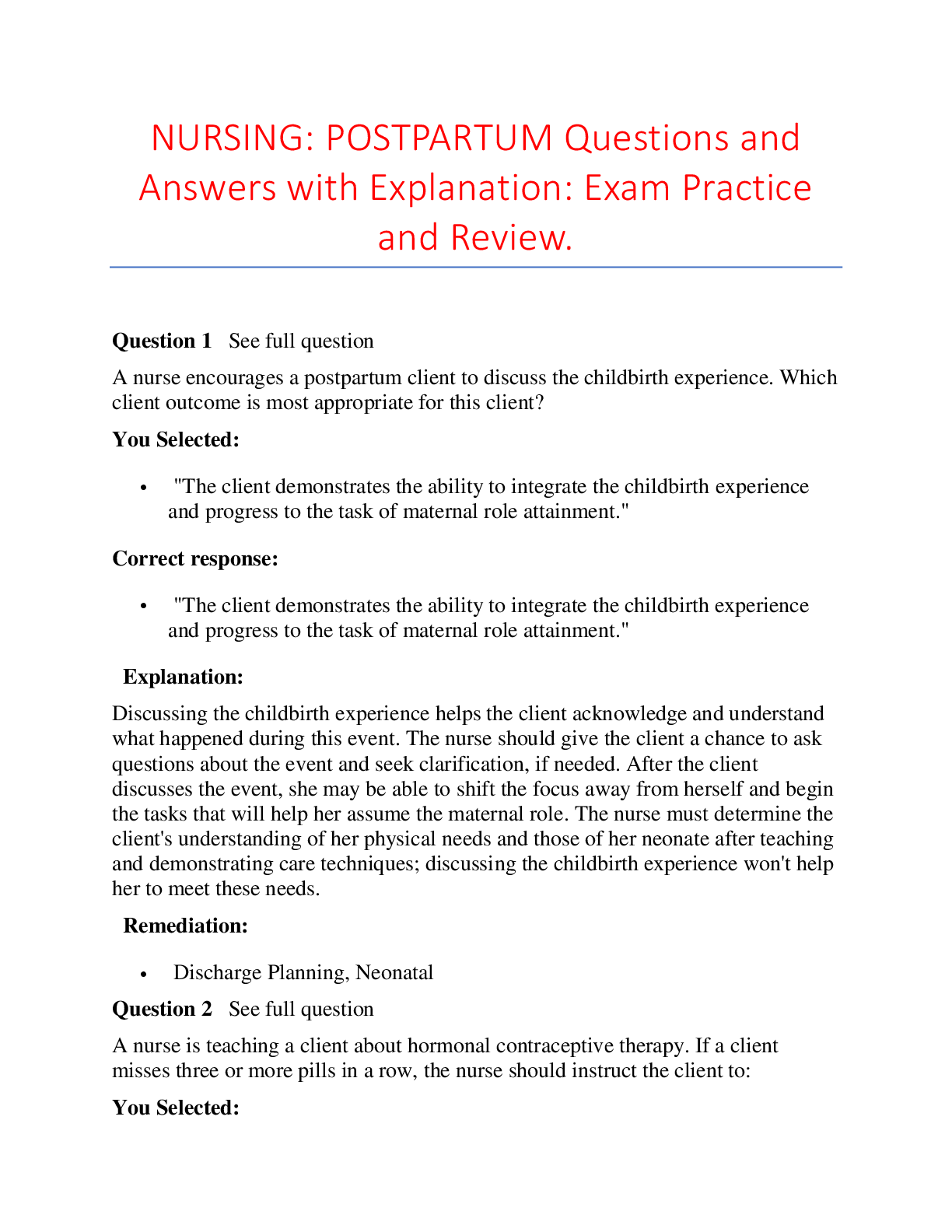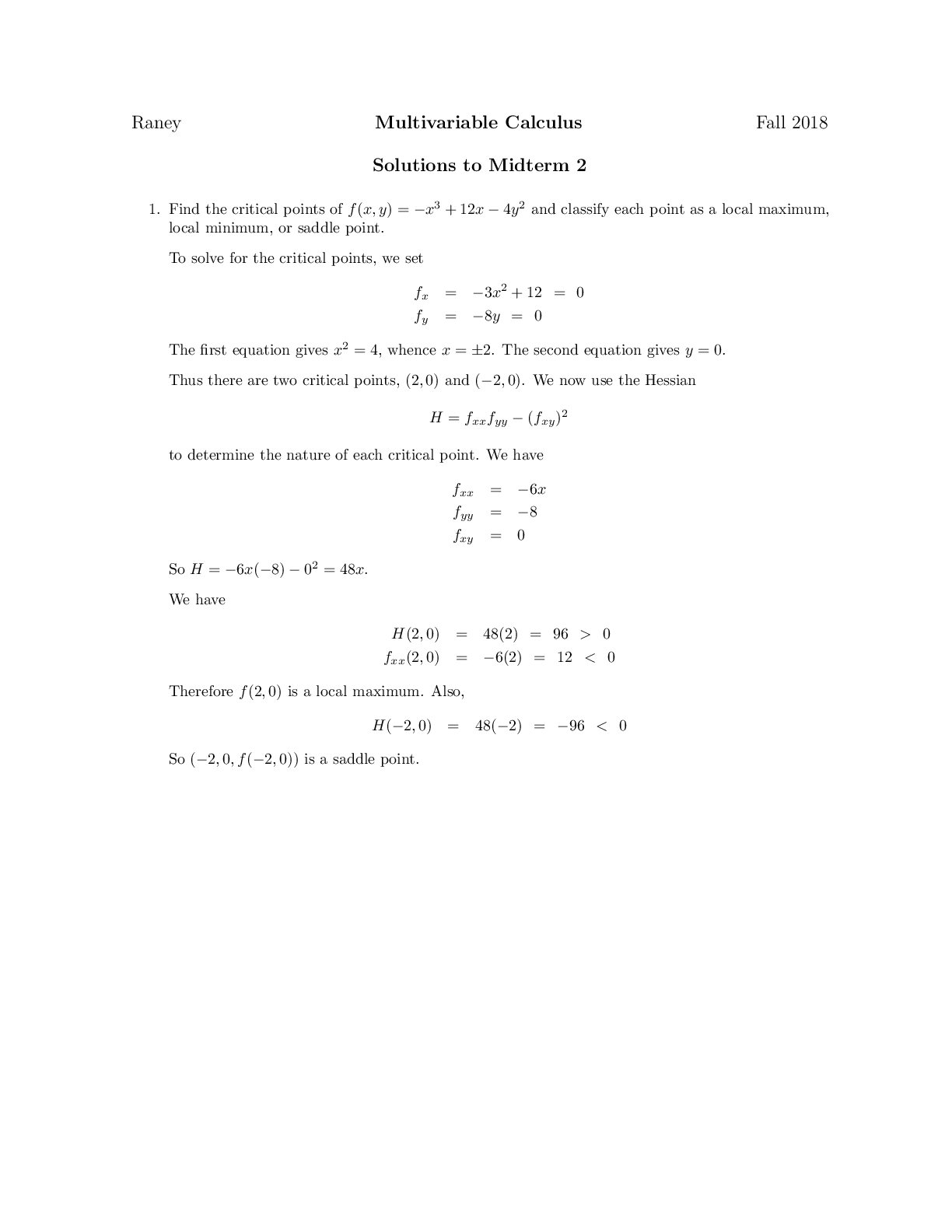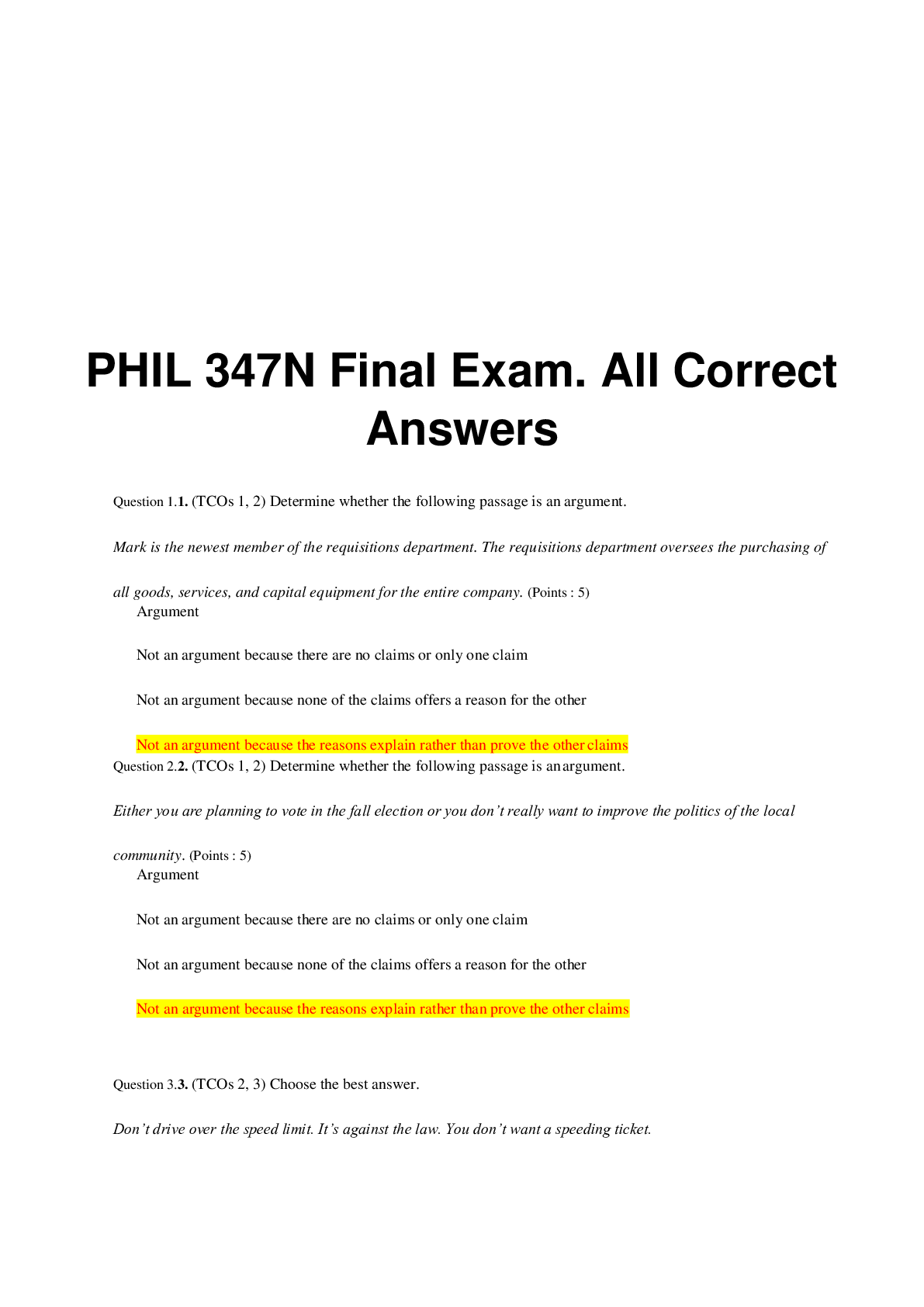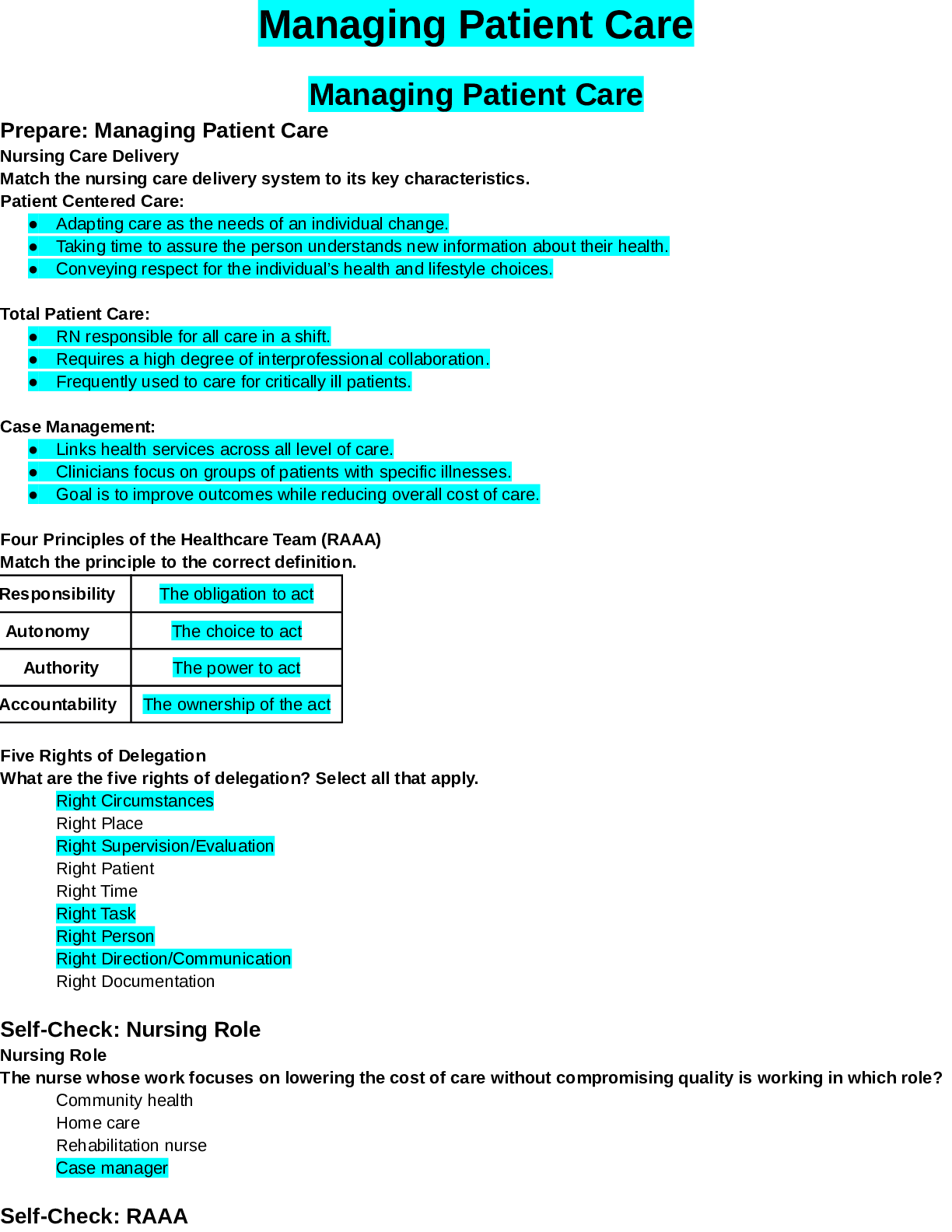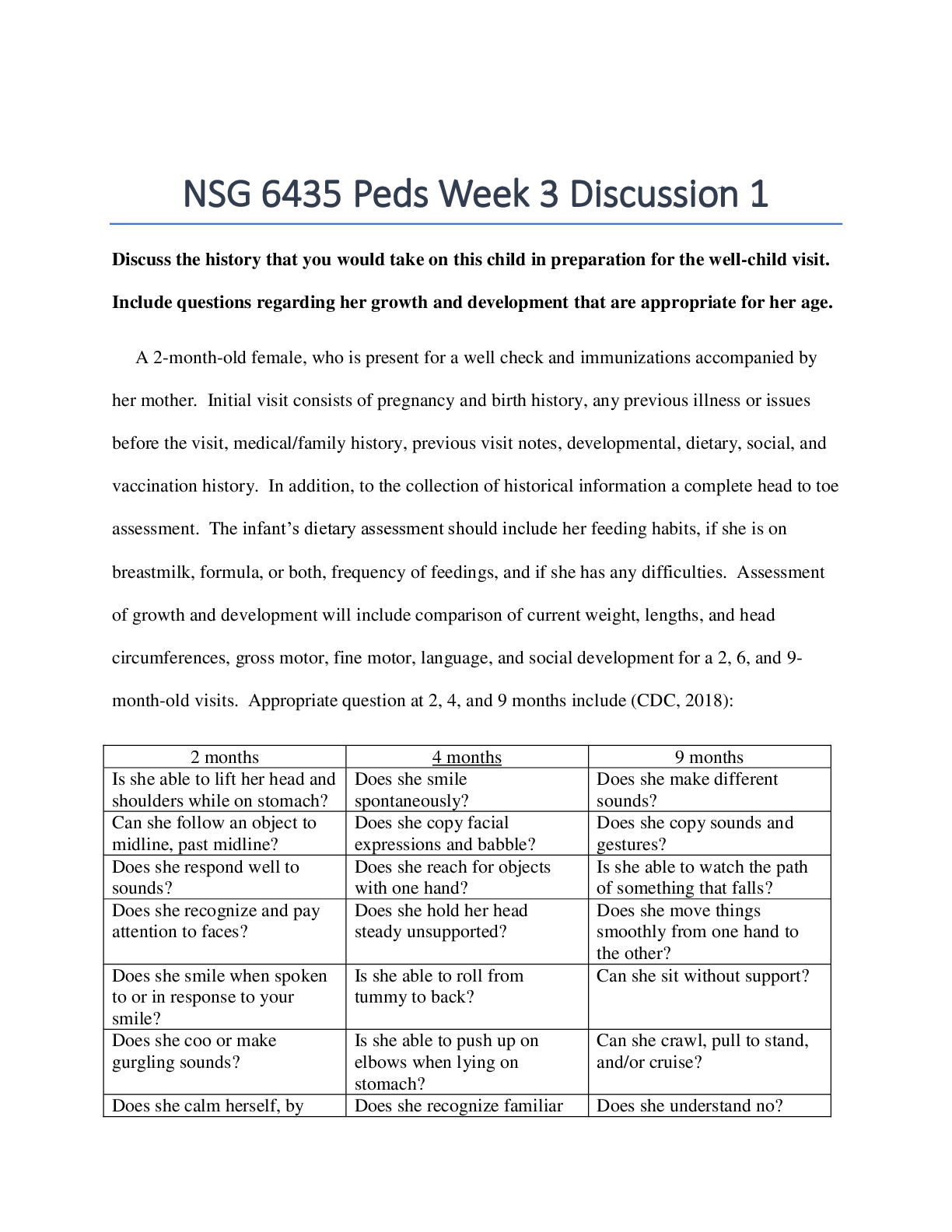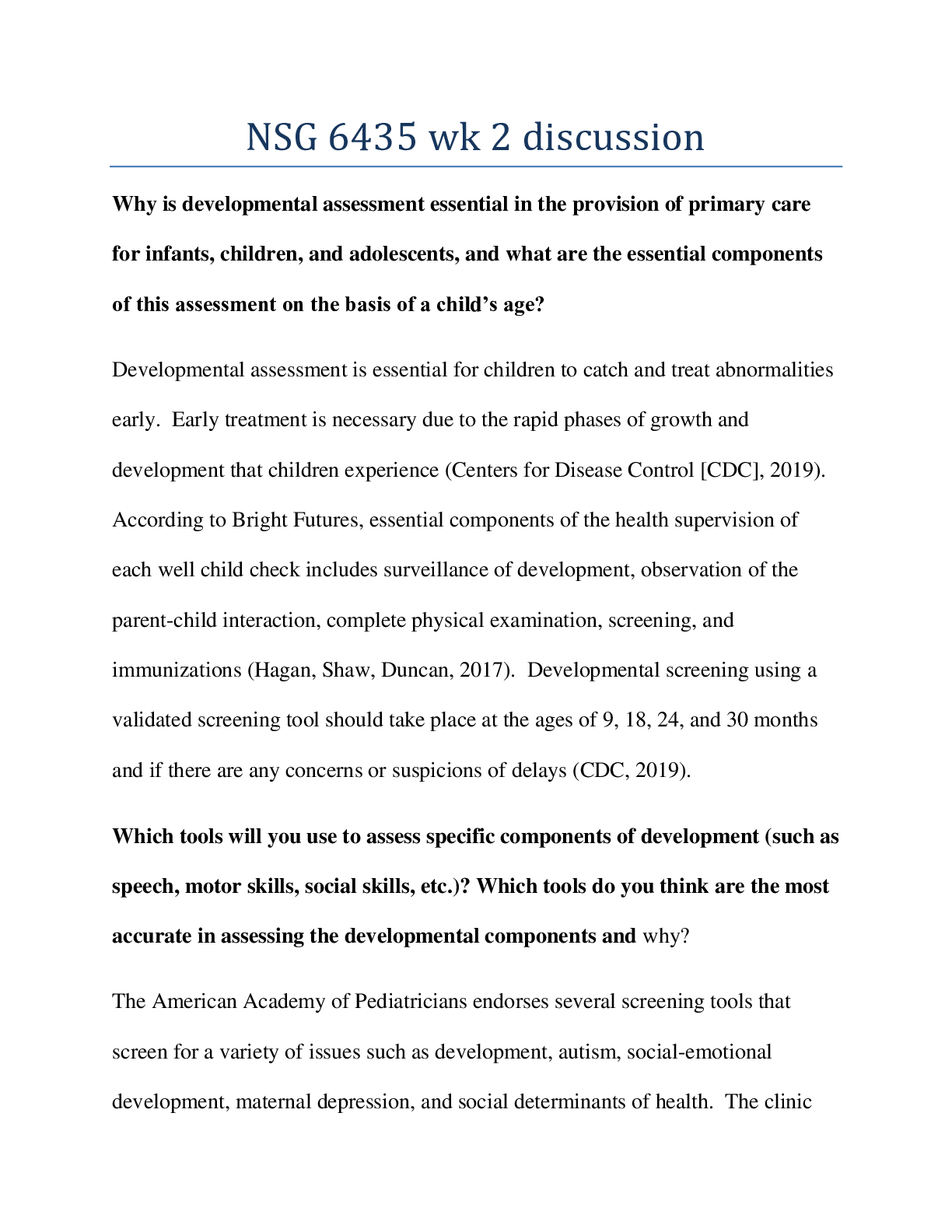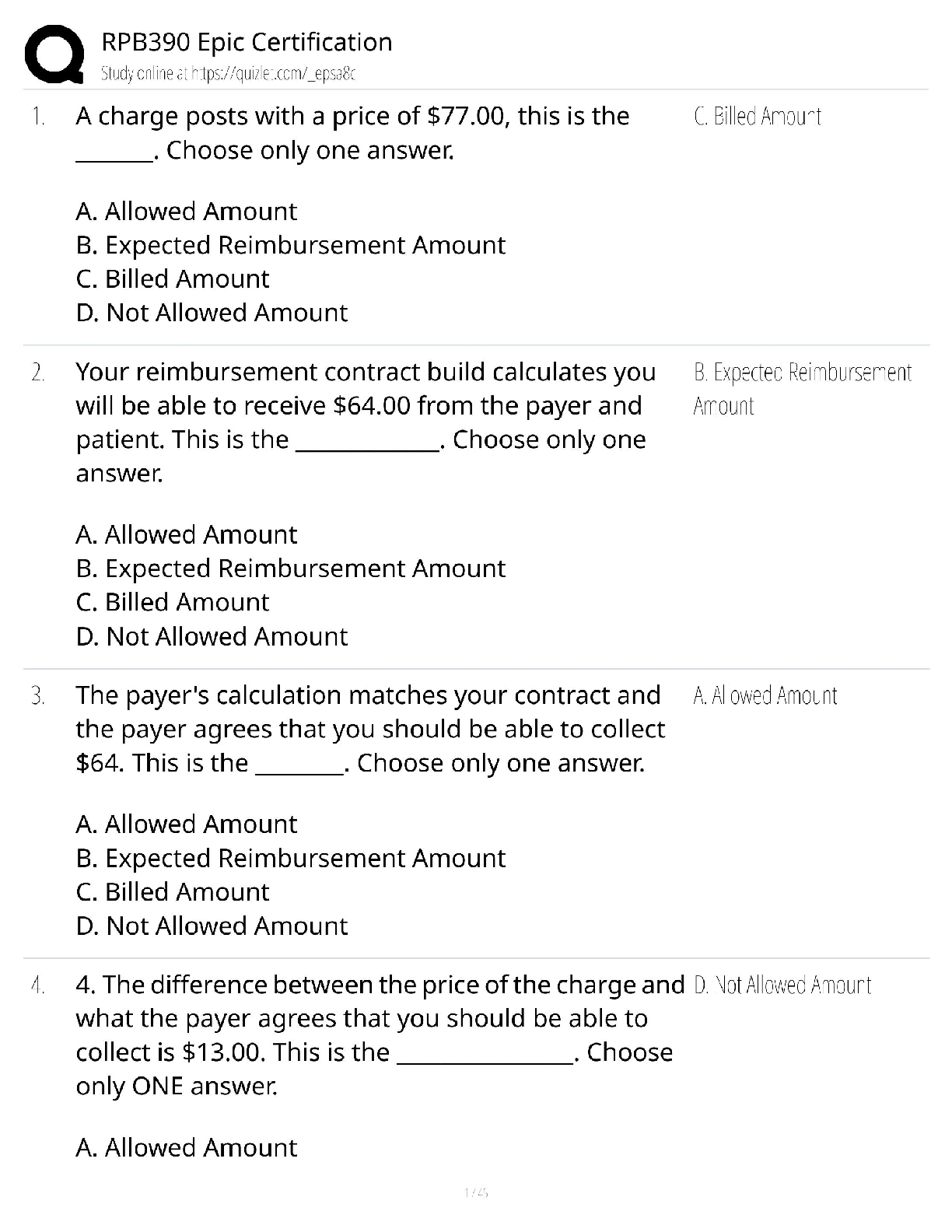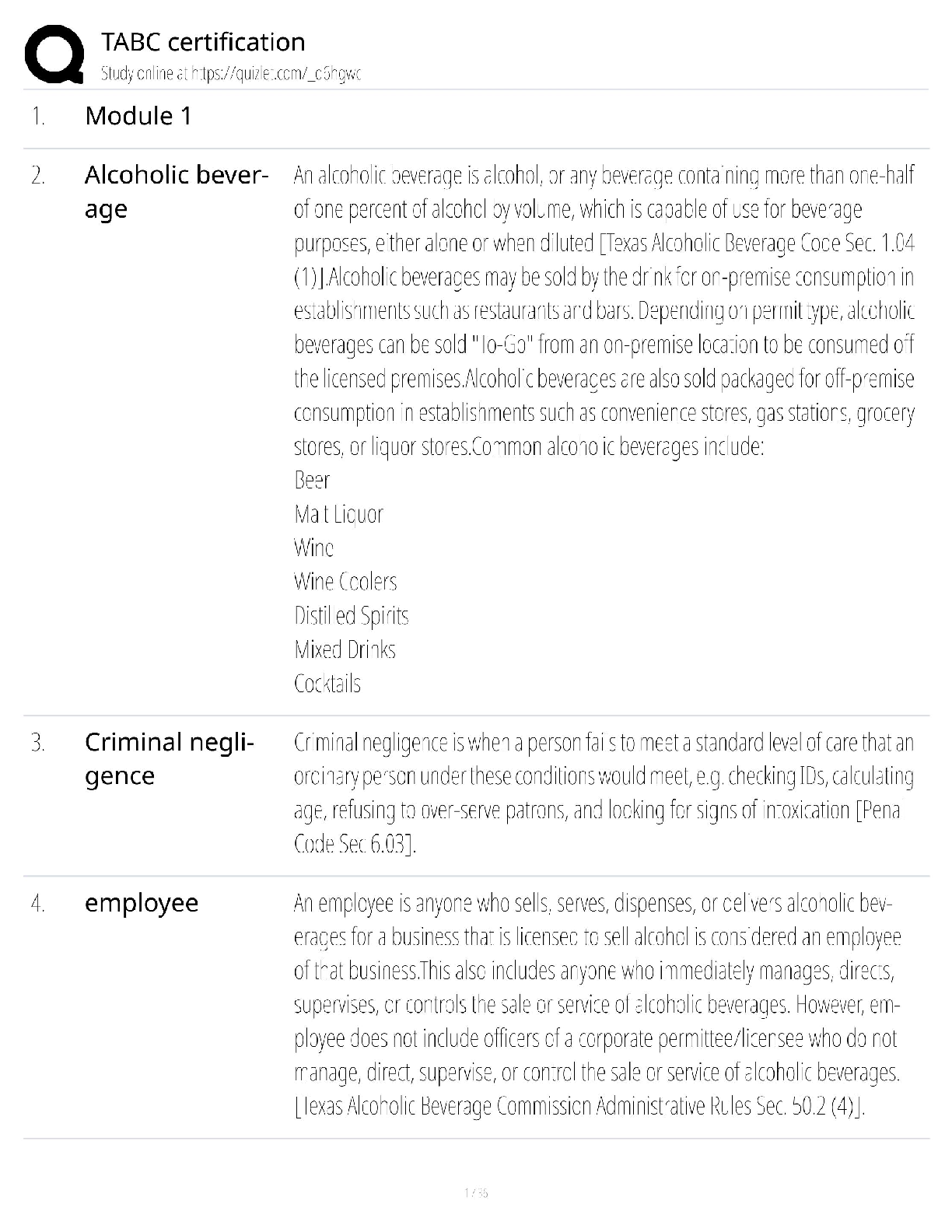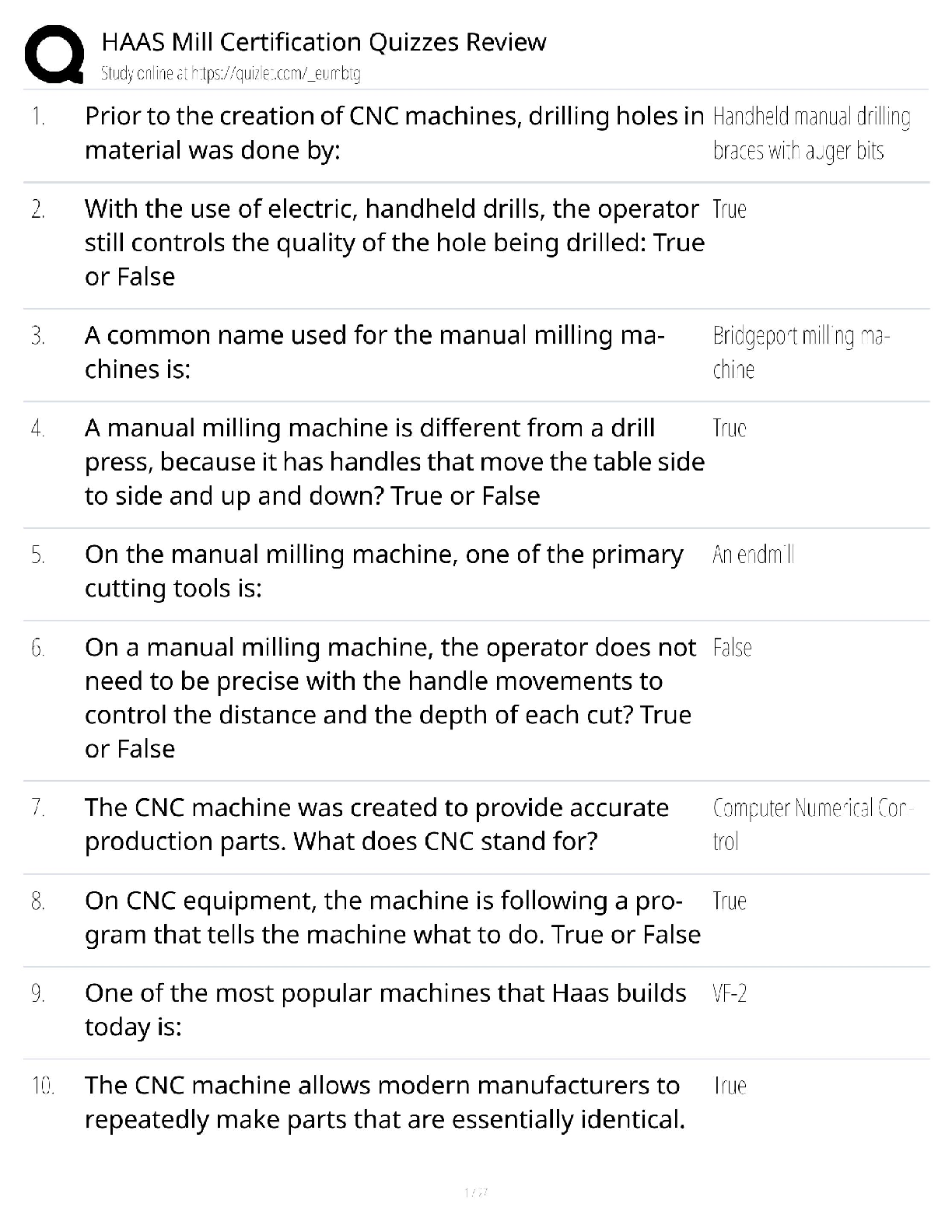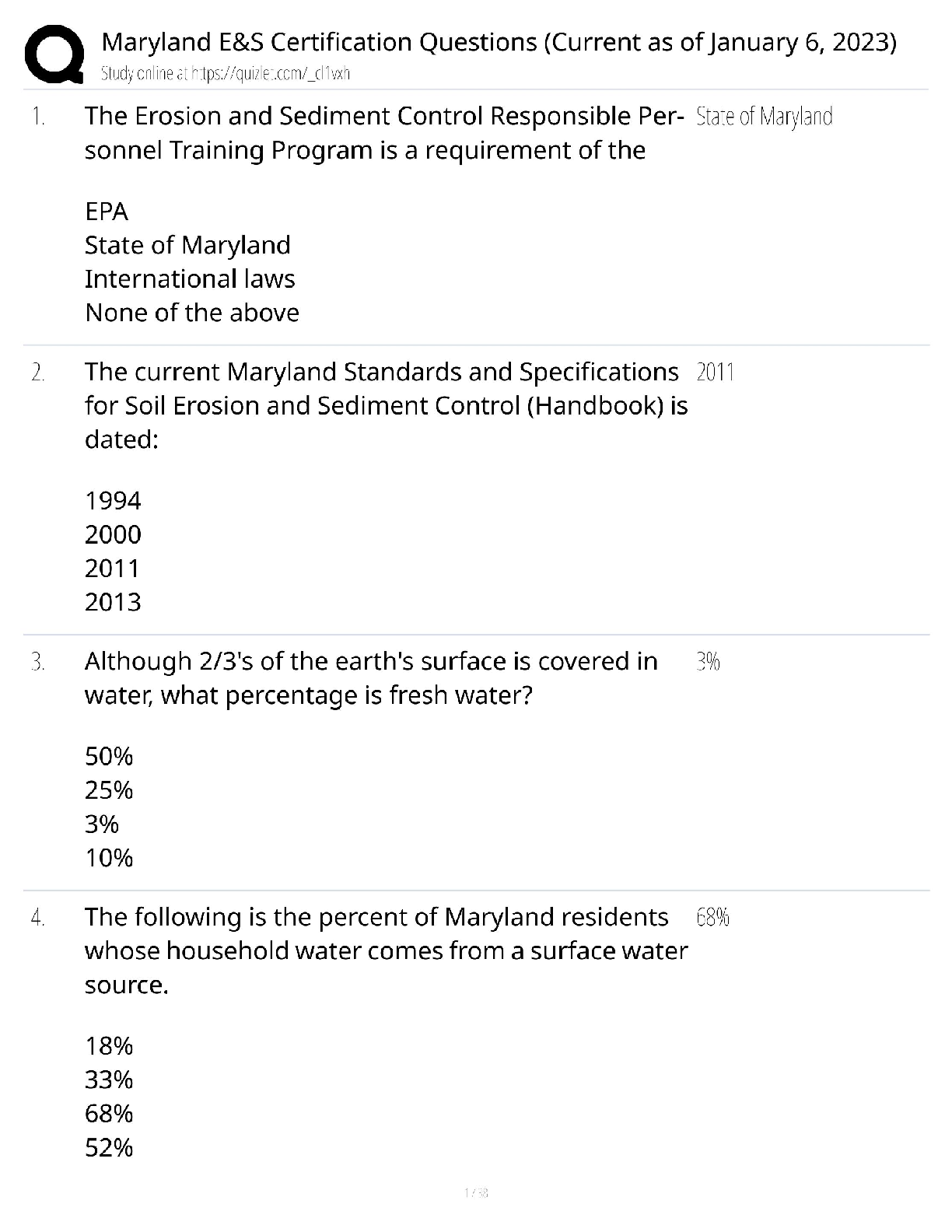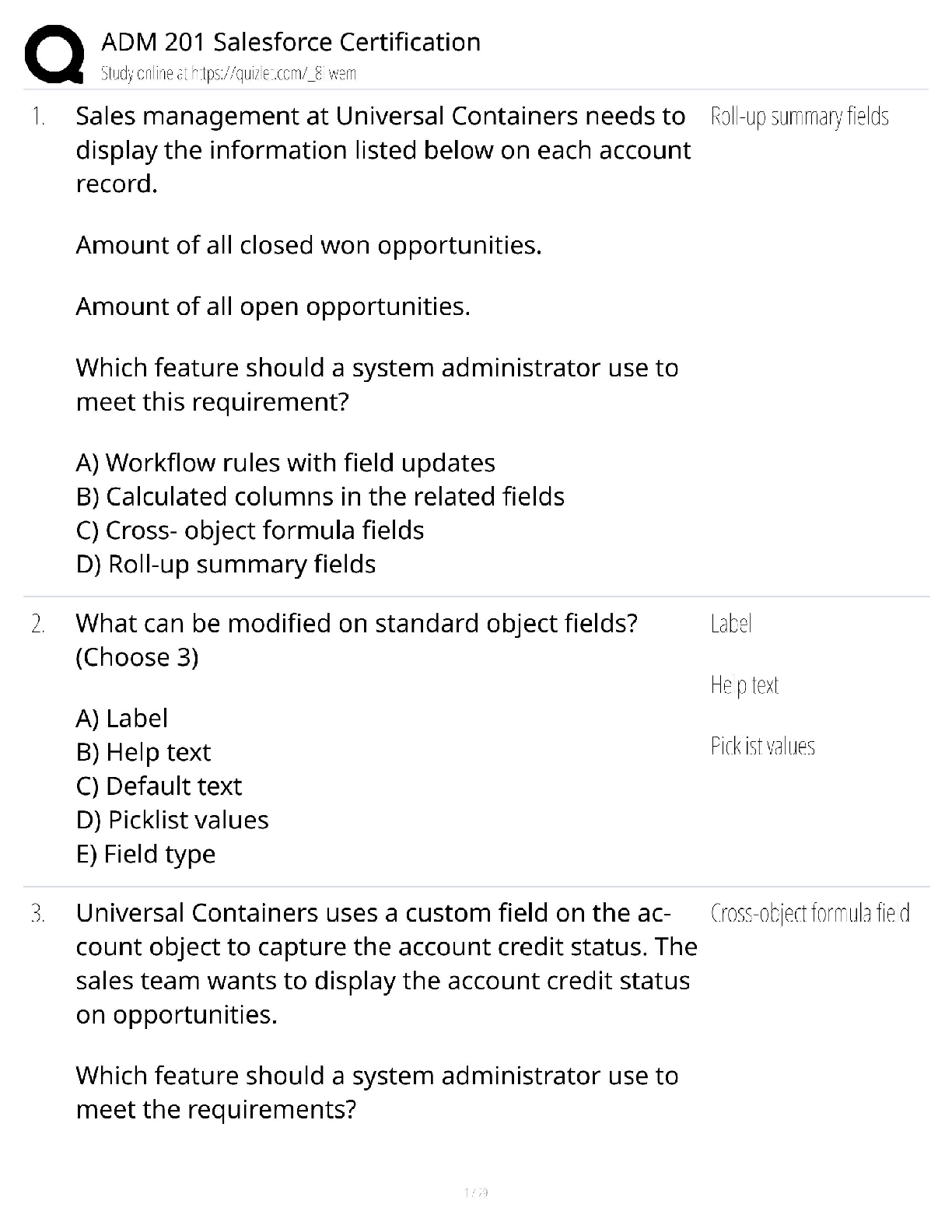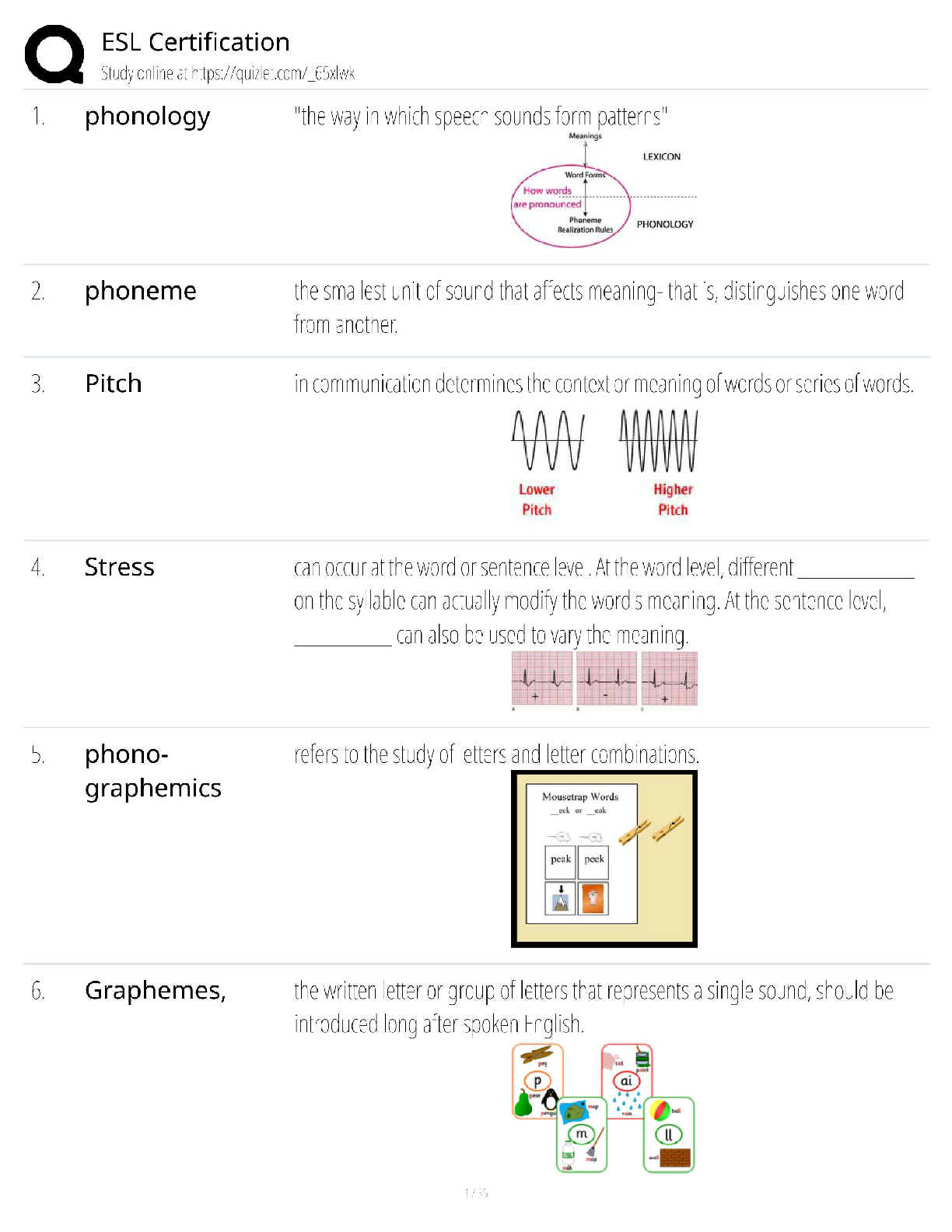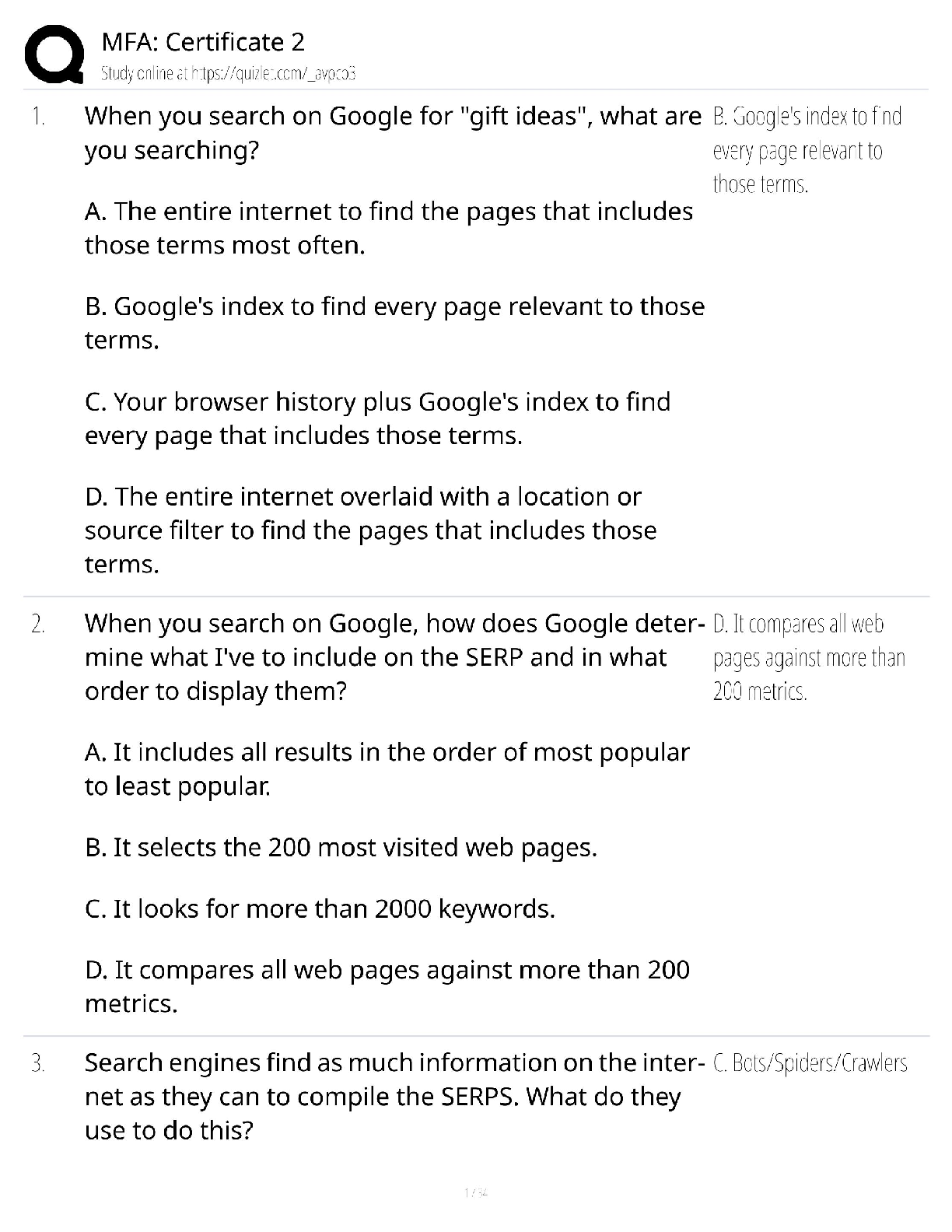Economics > QUESTIONS & ANSWERS > The University of Adelaide ECON 7200 Quiz 12. 50 Q&A_Score 100% (All)
The University of Adelaide ECON 7200 Quiz 12. 50 Q&A_Score 100%
Document Content and Description Below
Question 1 The supply of dollars in exchange for yen will decline, if, ceteris paribus: Answers : speculators think the value of the dollar will fall relative to the yen. Japanese interest rates ... rise relative to interest rates in other countries. there is a recession in Australia. the desirability of investing in Japan rises. Question 2 If the current account balance is negative: Answers : net foreign investment is also negative. net foreign investment is positive. capital inflows must be less than capital outflows. Both options of: net foreign investment is also negative; and capital inflows must be less than capital outflows, are correct. Question 3 Refer to Figure 18.3 for the following question(s). Figure 18.3. Since 1953, the USA has imposed a quota to limit imports of peanuts into the country. This figure illustrates the impact of the quota. (One pound = approximately 0.45 kilograms). Refer to Figure 18.3. What is the value of the deadweight loss as a result of the quota? Answers : $20 million. $8 million. $5.25 million. $17.25 million. Question 4Refer to Figure 19.3 for the following question(s). Which of the following would cause the change depicted in Figure 19.3? Note that the figure depicts the quantity of euros traded. Answers : The EU increases its quotas on Italian wine. Australians decrease their preferences for goods produced in the European Union (EU) relative to Australian goods. The price level of goods produced in the EU decreases relative to the price level of goods produced in Australia. Australian productivity falls relative to European productivity. Question 5 Australia ________ concerned with being a net borrower if Australia is using all of the borrowed funds to ________. Answers : should not be; finance consumption should be; finance investment should not be; finance investment should not be; pay off loans Question 6 Which of the following describes the national security argument for protectionism? Answers : Some goods should be insulated from foreign competition to ensure an adequate supply of these goods in the event of an international conflict. Private companies (for example, Coca-Cola) should not be forced to reveal their trade secrets to foreign companies. Increases in economic surplus outweigh the decreases in consumer surplus thatresult from protectionism. Nearly all industries can make some claim to strategic importance, so such trade restrictions can get out of hand. Question 7 In economics, the term 'dumping' refers to: Answers : selling a product in another country at a price below the cost of production. the loss associated with a tariff. giving up free trade, in essence, dumping it. foreign producers giving their products away free to gain customers. Question 8 GATT was: Answers : a post-WWII effort to reduce tariffs and revive international trade. an agreement to allow countries to raise tariffs to protect infant industries. an agreement to allow nations to protect industries necessary for national defence. All of these options are correct. Question 9 The idea of twin deficits refers to the possibility that a large federal budget deficit will lead to a: Answers : financial account deficit. trade surplus. current account deficit. balance of payments deficit. Question 10 How will the exchange rate (foreign currency per dollar) respond to an increase in the preference for imported goods by Australians in the long run, ceteris paribus? Answers : Exchange rates will rise. Exchange rates will fall. Exchange rates will be unaffected by changes in the preference for imported goods by Australians, both in the short run and in the long run. The exchange rate will be affected in the short run, but not in the long run.Question 1 Contractionary fiscal policy lowers the budget deficit. In an open economy this may ________ the foreign exchange value of the dollar, and ________ net exports. Answers : increase; increase reduce; increase reduce; decrease increase; decrease Question 2 Australia currently uses which of the following exchange rate systems? Answers : A managed float system. A fixed exchange rate system. A gold standard system. The Bretton Woods system. Question 3 Suppose that average productivity of Chinese firms increases more rapidly than the average productivity of Australian firms, then: Answers : production costs in China fall, quantity demanded for Chinese products rise, and the value of yuan falls against the dollar. production costs in China rise, quantity demanded for Chinese products falls, and the value of yuan falls against the dollar. production costs in China fall, quantity demanded for Chinese products rise, and the value of yuan rises against the dollar. production costs in China rise, quantity demanded for Chinese products rises, and the value of yuan rises against the dollar. Question 4 In an open economy, contractionary monetary policy will have a secondary effect on GDP because: Answers : net exports will fall due to the higher foreign exchange value of the dollar. net exports will fall due to the lower foreign exchange value of the dollar. net exports will rise due to the higher foreign exchange value of the dollar. net exports will rise due to the lower foreign exchange value of the dollar. Question 6 A federal budget deficit may ________ exchange rates (foreign currency per domestic currency), and ________ the balance of trade for goods and services.Answers : reduce; raise raise; reduce reduce; reduce raise; raise Question 8 Refer to Figure 18.3 for the following question(s). Figure 18.3. Since 1953, the USA has imposed a quota to limit imports of peanuts into the country. This figure illustrates the impact of the quota. (One pound = approximately 0.45 kilograms). Refer to Figure 18.3. What is the value of domestic producer surplus after the imposition of a quota? Answers : $17.25 million. $10.75 million. $15.75 million. $27.75 million. Question 9 Suppose that the European Union experiences a recession and this causes a decline in income in the European Union relative to Australia. Because of this, the dollar will, ceteris paribus: Answers : appreciate, and Australian net exports will rise. depreciate, and Australian net exports will fall. appreciate, and Australian net exports will fall. depreciate, and Australian net exports will rise. Question 10 If the Australian government sells a bond to the Bank of China, how is this recorded in Australia's balance of payments? Answers : An increase in foreign direct investment into Australia.A positive entry on the trade account. A negative entry on the financial account. Capital inflow into Australia's financial account. Question 2 Refer to Figure 18.1 for the following question(s). Answers: C+E+F. C+G. C. B. Question 3 One advantage of adopting a fixed exchange rate is that: Answers : interest cost fluctuations on foreign loans can be avoided. inflation can be avoided. the country can avoid current account surpluses. it makes business planning easier. Question 4 In an open economy, expansionary monetary policy will have the added effect of causing the: Answers : exchange rate to depreciate and net exports to increase. exchange rate to depreciate and net exports to decrease. exchange rate to appreciate and net exports to decrease. exchange rate to appreciate and net exports to increase.Question 5 Refer to Figure 19.1 for the following question(s). Consider the market for dollars against the British pound shown in Figure 19.1. From this graph, we can conclude that the dollar price of a British pound has ________ to ________ dollars per pound. Answers : decreased; 0.46 increased; 2.17 increased; 0.50 decreased; 2.00 Question 6 The large current account deficit in Australia means that: Answers : foreign investors lack confidence in the strength of the Australian economy and the buying power of Australian consumers. private savings have been at historically high levels. there has been little or no foreign investment in Australia. foreign investors accumulate more Australian assets than Australian investors accumulate foreign assets. Question 7 Suppose that Argentina and Chile both produce copper and wheat, and that Argentina has an absolute advantage in the production of both goods. If Chile has a lower opportunity cost for producing copper, then: Answers : Chile has a comparative advantage in the production of copper, but it is outweighed by Argentina's absolute advantage in wheat production. Argentina has a comparative advantage in the production of both goods. Chile has a comparative advantage in the production of copper, and specialisation and trade between the two countries can be mutually beneficial. Chile has a comparative advantage in wheat production, but there will be no gains from specialisation and trade. Question 8 Among the reasons some groups oppose globalisation is: Answers : because some believe that globalisation favours the more developed nations at the expense of the less developed ones.because some groups believe globalisation tends to destroy distinctive cultures. because some groups are against foreign competition from producers with comparative advantages. All of these options are correct. Question 9 Your friend argues that Australian producers cannot compete with some foreign producers because wages are lower in some foreign countries than in Australia. Your friend is: Answers : right in asserting the need to use protectionism in order to protect high wages in Australia. using the anti-dumping argument for protectionism. correct in arguing that the relatively high wages in Australia make it impossible to compete with low-wage countries. incorrect. Free trade raises living standards by increasing economic efficiency. Question 2 If CAB = current account balance, I = private sector investment, S = national saving and NX = net exports, then: Answers : CAB + NX = S. CAB + I = S. I = CAB - S. CAB = I + NX. Question 3 If S = national saving, I = private investment and NFI = net foreign investments, then: Answers : S = I - NFI. S = I + NFI. S + I = NFI.S + NFI = I. Question 4 Assume the exchange rate between the dollar and yen is ¥80= $1. Suppose that the exchange rate changes to ¥75 = $1. As a result of the change, there will be: Answers : more Japanese goods sold in Australia and the same amount of Australian goods sold in Japan. more Japanese goods sold in Australia and less Australian goods sold in Japan. less Japanese goods sold in Australia and more Australian goods sold in Japan. the same number of Japanese goods sold in Australia and less Australian goods sold in Japan. Question 5 Refer to Figure 18.3 for the following question(s). Figure 18.3. Since 1953, the USA has imposed a quota to limit imports of peanuts into the country. This figure illustrates the impact of the quota. (One pound = approximately 0.45 kilograms). Question 7 Refer to Figure 18.1 for the following question(s). Question 10 Refer to Figure 19.3 for the following question(s).Which of the following would cause the change depicted in Figure 19.3? Note that the figure depicts the quantity of euros traded. Answers : The European Union increases its quotas on German wrist watches. European productivity rises relative to Australian productivity. Japanese decrease their preferences for goods produced in the EU relative to Australian goods. The price level of goods produced in the EU increases relative to the price level of goods produced in Australia. Question 1 The protectionist argument that economists consider the most persuasive is Answers : protecting national security. protecting infant industries. protecting high wages. saving jobs. Question 2 A federal budget deficit can lead to a(n): Answers : appreciation of the dollar and an increase in net exports. appreciation of the dollar and a decline in net exports. depreciation of the dollar and a decline in net exports. depreciation of the dollar and an increase in net exports. Question 3 Refer to Figure 18.3 for the following question(s). Figure 18.3. Since 1953, the USA has imposed a quota to limit imports of peanuts into the country. This figure illustrates the impact of the quota. (One pound = approximately 0.45 kilograms).Question 7 Which of the following is not a potential benefit from trade? Answers : It allows import competition industries to increase production. It increases productive efficiency. It enables consumption beyond the production possibility frontier. It allows consumers to buy goods more cheaply. Question 1 If prices rise faster in the United States of America (USA) than in Australia, and USA goods become relatively more expensive: Answers : demand for the $US declines and the $US appreciates relative to the Australian dollar. demand for the $US increases and the $US depreciates relative to the Australian dollar. demand for the $US increases and the $US appreciates relative to the Australian dollar. demand for the $US declines and the $US depreciates relative to the Australian dollar. Question 3 The United States of America implements a quota on imported cotton. This will ________ the supply of United States dollars relative to the currencies of foreign cotton producers and lead to a(n) ________ of United States dollars relative to these foreign currencies. Answers : decrease; appreciation increase; appreciation decrease; depreciation increase; depreciation Question 6 Suppose that interest rates increase in Japan and at the same time the Japanese economy is experiencing a recession. What will happen to the value of the dollar relative to the yen?Answers : There will be no change in the relative exchange rate. One would have to know the size of the demand shift relative to the supply shift to answer correctly. The dollar will appreciate relative to the yen. The dollar will depreciate relative to the yen. Question 7 Refer to Figure 19.1 for the following question(s). Refer to Figure 19.1. Which of the following events cause the shifts in the supply and demand curves in the market for dollars against the British pound shown in the graph above? Answers: Interest rates rise in England. Real income falls in England. Real income rises in Australia. Interest rates rise in Australia. Question 8 Domestic producers require time to gain experience and lower their unit costs; this will allow these producers to compete successfully in international markets. This statement describes the ________ argument for protectionism. Answers : infant industry protecting national security anti-dumping diseconomies of scale Question 3 All but one of the following statements is used to justify protectionism. Which statement is not used to justify protectionism?Answers : A country should not rely on other countries for goods that are critical to its national defence. Free trade reduces employment by driving domestic firms out of business. Trade restrictions are necessary to protect new firms until they can gain experience and become more productive. Free trade leads to higher prices for imported goods. Question 5 When countries aim to keep the value of their currency within a range against another currency, their exchange rate system is referred to as: Answers : variable. floating. a pegged float. managed float. Question 8 If nation A can produce 20 power plants and 16 ships, while nation B can produce 18 power plants and 12 ships, then nation B's opportunity cost to produce a power plant is Answers : 1.5 ships. 0.67 ship. 12 ships. impossible to determine without more information. Question 2 It is difficult to determine if foreign companies are selling their products for prices below their costs of production because: Answers : the firms have no legal obligation to reveal this information. costs are calculated in the firms' local currencies. domestic taxes increase the firms' costs but it is difficult to determine the incidence of these taxes. the true costs of production are difficult to calculate. Question 4 Refer to Figure 18.1 for the following question(s).Question 6 Refer to Figure 18.2 for the following question(s). Figure 18.2 The effect if the US government imposes a $0.75 per pound tariff on coffee imports into the USA. (One pound = approximately 0.45 kilograms). Refer to Figure 18.2. The loss in domestic consumer surplus as a result of the tariff is equal to: Question 9 If net primary income and net secondary income are $0, and a country's purchases of foreign goods and services are $25 billion while its sales of goods and services overseas are $26 billion, it has a: Answers : surplus of $26 billion in its current account. $1 billion surplus in its current account. surplus of $1 billion in its balance of payments. $1 billion deficit in its current account. Question 8 Economists may support barriers to trade:Answers : because the transportation of goods increases carbon dioxide emissions. if dumping is occurring. if trade is occurring with a country with low environmental standards. All of these options are correct. [Show More]
Last updated: 3 years ago
Preview 1 out of 15 pages
.png)
Buy this document to get the full access instantly
Instant Download Access after purchase
Buy NowInstant download
We Accept:

Reviews( 0 )
$9.00
Can't find what you want? Try our AI powered Search
Document information
Connected school, study & course
About the document
Uploaded On
Aug 03, 2022
Number of pages
15
Written in
All
Additional information
This document has been written for:
Uploaded
Aug 03, 2022
Downloads
0
Views
103


